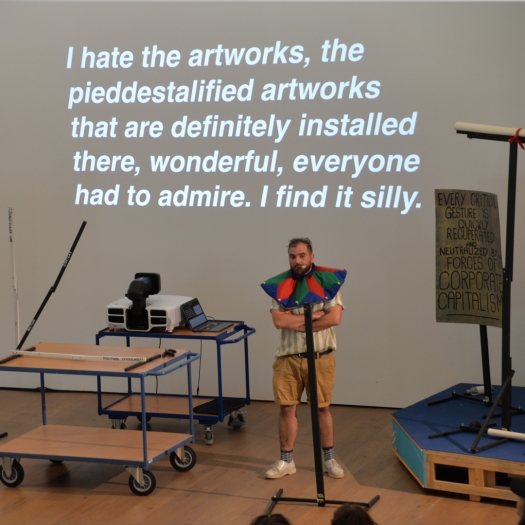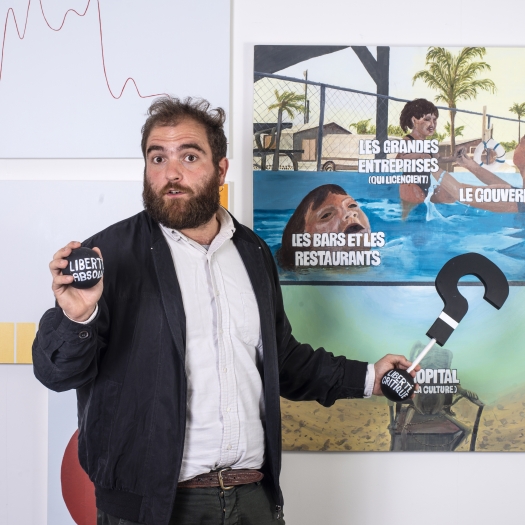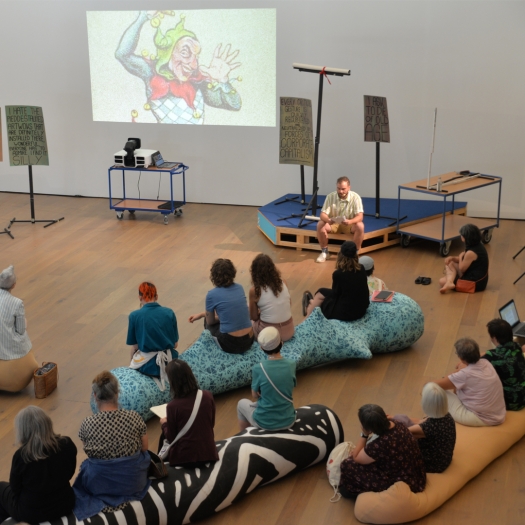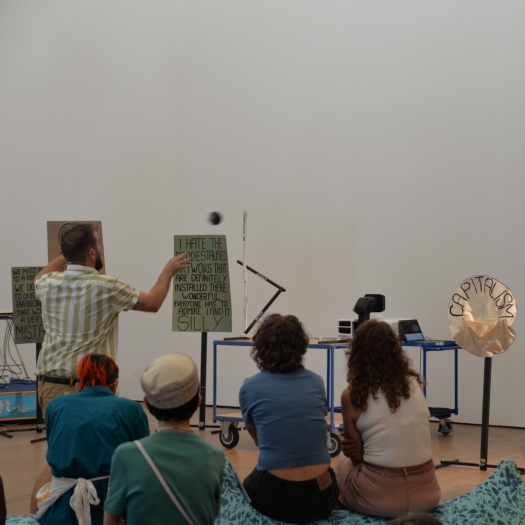Darren Roshier
Travailleur·euse culturel·le : du technicien·ne à l’artiste, ou l’inverse est un projet de recherche et de production artistique visant à explorer la notion de travail culturel. À travers une exposition, une performance et l’organisation d’une table ronde, ce projet s’intéresse au lien entre le travail du technicien et celui de l’artiste.
Ce projet trouve son origine dans une réalité à la fois biographique et professionnelle. Comme beaucoup d’artistes, je cumule plusieurs emplois afin de subvenir à mes besoins : artiste, technicien d’exposition, vidéaste ou encore professeur d’art. En avril 2024, j’ai travaillé comme technicien à L’Escaut pour le montage d’une exposition ambitieuse en termes de construction : The Red Box, de l’architecte et artiste australien Jan van Schaik et artiste Olivia Lennon. Cette œuvre constitue une sorte de miroir de l’espace d’exposition de L’Escaut, reprenant les éléments phares de son architecture.
Invité à participer au projet, cette fois-ci comme artiste et non comme technicien, l’idée de poursuivre et de questionner différemment le travail autour du miroir m’a semblé évidente. Entre artiste et technicien·ne, comment ces deux activités se répondent-elles et se nourrissent-elles mutuellement ?
Le projet prend ainsi la forme d’une recherche artistique personnelle aboutissant à une exposition et une performance. Il inclut également l’invitation de technicien·ne·s à présenter des traces de leur processus de travail, ainsi qu’une table ronde sur les conditions de travail des technicien·ne·s culturel·le·s.
Avec l'aide de la Fédération Wallonie-Bruxelles, Service Général de la Création Artistique
Travailleur-euse culturel-le : du technicien-ne à l'artiste, ou l'inverse is een onderzoeks- en artistiek productieproject dat de notie van cultureel werk onderzoekt. Door middel van een tentoonstelling, een performance en de organisatie van een ronde tafel onderzoekt dit project de link tussen het werk van de technicus en dat van de kunstenaar.
Het project is geworteld in een realiteit die zowel biografisch als professioneel is. Zoals veel kunstenaars heb ik meerdere banen om in mijn levensonderhoud te voorzien: kunstenaar, tentoonstellingstechnicus, videokunstenaar en kunstdocent. In april 2024 werkte ik als technicus in L'Escaut om een tentoonstelling op te zetten die qua constructie ambitieus was: The Red Box van de Australische architect en kunstenaar Jan van Schaik and Kunstenaar Olivia Lennon. The Red Box weerspiegelt de tentoonstellingsruimte van L'Escaut en bevat belangrijke elementen van de architectuur.
Uitgenodigd om deel te nemen aan het project, deze keer als kunstenaar in plaats van als technicus, leek het idee om het werk rond de spiegel op een andere manier te benaderen en in vraag te stellen me voor de hand liggend. Hoe reageren deze twee activiteiten op elkaar en hoe werken ze op elkaar in?
Het project neemt de vorm aan van persoonlijk artistiek onderzoek dat uitmondt in een tentoonstelling en een performance. Het omvat ook het uitnodigen van technici om sporen van hun werkproces te presenteren, evenals een rondetafelgesprek over werkomstandigheden.
Travailleur-euse culturel-le : du technicien-ne à l'artiste, ou l'inverse is a research and artistic production project exploring the notion of cultural work. Through an exhibition, a performance and the organisation of a round table, this project looks at the link between the work of the technician and that of the artist.
The project is rooted in a reality that is both biographical and professional. Like many artists, I hold down several jobs in order to support myself: artist, exhibition technician, video artist and art teacher. In April 2024, I worked as a technician at L'Escaut to set up an exhibition that was ambitious in terms of construction: The Red Box, by Australian architect and artist Jan van Schaik and artist Olivia Lennon. The Red Box mirrors the exhibition space at L'Escaut, incorporating key elements of its architecture.
Invited to take part in the project, this time as an artist rather than a technician, the idea of pursuing and questioning the work around the mirror in a different way seemed obvious to me. Between artist and technician, how do these two activities respond to and feed off each other?
The project takes the form of personal artistic research culminating in an exhibition and a performance. It also includes inviting technicians to present traces of their work process, as well as a round-table discussion on working conditions.



